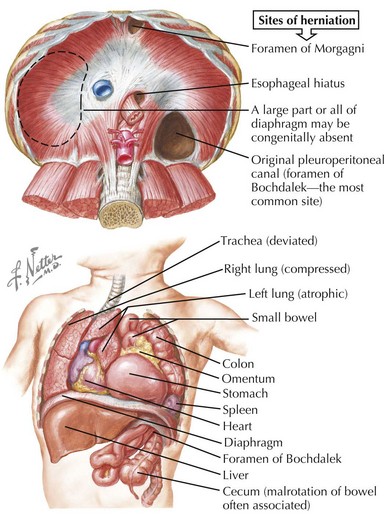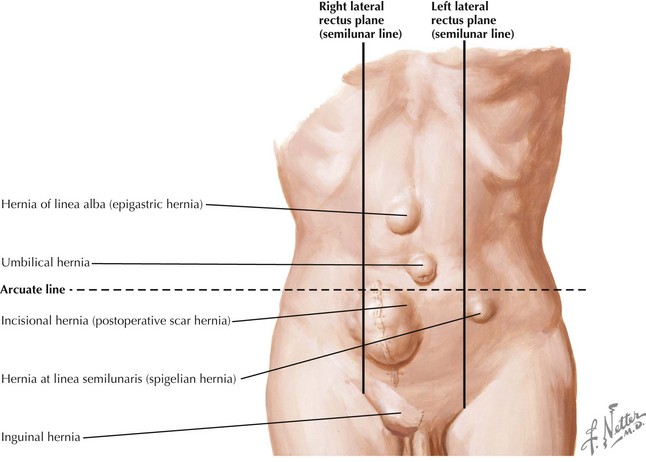113 Hernias
Congenital diaphragmatic hernia (CDH) and hiatal hernia are the two most common internal hernia types among children. CDH is a neonatal surgical emergency that presents with a scaphoid abdomen, cyanosis, and respiratory distress within minutes of birth as a result of the herniation of abdominal contents into the thoracic cavity (Figure 113-1 see Chapter 102). Hiatal hernias, in which intraabdominal portions of the esophagus, the stomach, or both pass into the thorax, are less common in children than adults but remain an important consideration in certain clinical circumstances. Other internal hernias, including paraduodenal and mesenteric hernias, occur within the abdominal cavity. These are largely the result of congenital abnormalities and in rare circumstances become clinically relevant in childhood.
Etiology and Pathogenesis
External Hernias
Inguinal Hernia
Indirect inguinal hernias are congenital in origin, arising from incomplete embryogenesis. In boys, the testes are initially in a retroperitoneal position. A portion of peritoneum called the processus vaginalis attaches to the testes and precedes the testicular descent through the internal inguinal ring into the scrotal sac. The testes are located at the internal inguinal ring by 28 weeks of gestation and reach their final destination by 36 weeks with the left side completing its descent slightly earlier than the right. The processus vaginalis creates a patent conduit between the abdomen and the scrotum via the inguinal canal and typically obliterates between 36 and 40 weeks of gestation or in the postnatal period. If the processus vaginalis remains patent, abdominal contents may escape through the internal inguinal ring into the inguinal canal and the scrotum (Figure 113-2).
Abdominal Wall Hernias
Epigastric hernias occur above the umbilicus through a defect in the linea alba and most commonly contain preperitoneal fat. Such a defect develops when there is failure of complete approximation of the midline during the final stages of abdominal wall formation. Incisional hernias, resulting from incomplete healing of a surgical incision, can occur anywhere on the abdomen. Any process that increases intraabdominal pressure, obesity, and postoperative wound infections are major risk factors for incisional hernias. Spigelian hernias, reported rarely in children, occur in an area of natural weakness at the lateral edge of the rectus abdominus muscle and below the arcuate line where only transversalis fascia lies posterior to the rectus abdominus (Figure 113-3).










